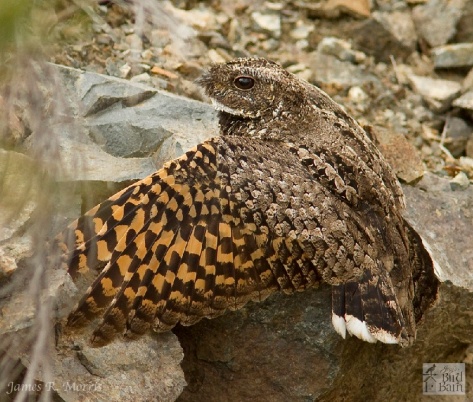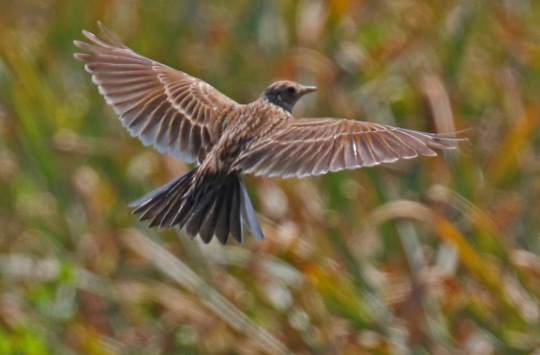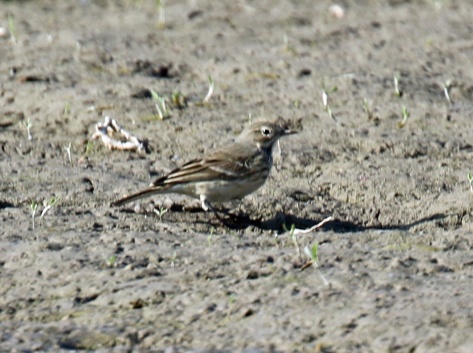As I wrote earlier, May is the best – lots of new birds as migration is in full swing and birders are out finding and reporting great birds. Prompted in part by the recently reported Black Backed Woodpecker seen in a burn near Cle Elum and my ongoing desire for a photo of a Flammulated Owl, I planned a long trip into Eastern Washington to try for both and to see other birds that had come into the state. Frank Caruso had seen the Black Backed Woodpecker with the Pilchuck Audubon Group on Tuesday. It had been a nemesis bird for him and when found a new ABA Life bird! Building on that success, he joined me hoping for any Flammulated Owls – a second life bird for the week. We had a great trip!!
We started with a stop at the hummingbird feeders at Hyak on Snoqualmie Pass. Lot of Rufous Hummingbirds and a good assortment of Warblers – Nashville, MacGillivray’s, Yellow and Townsend’s. Then it was off to look for the Black Backed Woodpecker with a relatively quick stop at Bullfrog Pond which has become part of every trip to the area. It was fairly quiet and there were no Sapsuckers. Frank got his FOY Cedar Waxwing and then I had a scare as my camera seemed to be malfunctioning. It turned out to be operator error (surprise) and Photoshop and I were even able to rescue a pretty nice photo of a Hammond’s Flycatcher.
Hammond’s Flycatcher

Then it was on to try for the Black Backed Woodpecker. This species is generally found in burned areas where the damaged trees are susceptible to attacks by insects which provide the food for these Woodpeckers. We parked at the gate at NF 230 just off the Middle Fork Teanaway Road and hiked in. After maybe a quarter of a mile we reached the spot where Frank had seen the woodpeckers earlier. Nothing… Then after going a little further up the road, we heard some tapping and located the area easily. But we just could not find the bird. I thought I heard a second bird tapping and then got a brief view on a snag. I climbed up off the road into the burned trees. The tapping was louder and I knew I must be close but could not find the Woodpecker – until of course I looked at the right snag – the one right in front of me. And there it was – a great photo op. Meanwhile Frank located the first woodpecker – a twofer!!
Black Backed Woodpecker

Very pleased, we headed off to Ellensburg to look for a Long Billed Curlew with a stop at the Bank Swallow colony at the intersection of Highway 10 and Reecer Road. We had seen Bank Swallows there several weeks earlier with Deb Essman but had not found the nest cavities. Maybe we had not looked hard enough then, but it was easy this day as there were 75+ Bank Swallows flying everywhere and easy to follow to the nests.
Bank Swallow Nests in Bank and Bank Swallow Leaving Cavity


We probably spent an hour driving road after road looking for a Long Billed Curlew – no success – one of the very few disappointments this day. Our next specific target was to find a Lark Sparrow. Deb had some off Recreation Road earlier in the week so we headed out Vantage Highway. Unlike most other trips to the area, we made no stops along the way looking for Sage Shrub Steppe species. Not too far from the Recreation Road turnoff, we had a one-two-three sequence of birding surprises and treats. First we spotted a single Chukar right on the road. It climbed onto some rocks and posed for a wonderful photo.
Chukar

A moment later I caught a quick look at a bird and thought it might be a Loggerhead Shrike. Not that unusual here, but it was the one species we had missed when we visited this same area with Frank’s East Coast birding friend the previous week. A Loggerhead it was. Then moments later I noted what appeared to be an Osprey sitting on a rock. Ospreys are not uncommon in the area – but we had never seen one here – more than a mile from the Columbia – or any water – no food sources and no nesting area. A surprise. We turned onto Recreation Road and got ready to hike up into the Canyon – where Deb (always enthusiastic) had said Lark Sparrows “were everywhere”.
As soon as we got out of the car, we heard a Lark Sparrow singing. It turned out to be in the open on the tree right at the road. We did not have to walk even 25 feet. A new year bird for both of us.
Lark Sparrow

We carried on into the Canyon – a really beautiful spot. Frank hoped to break his year long jinx and find a Canyon Wren. I thought we might find more sparrows and hoped for a Yellow Breasted Chat in the riparian area less than 1/2 mile in. Suddenly a bird rocketed off the path just in front of us and made a beeline for the other side of the draw. It happened so fast, there was no time to grab the camera and our minds raced to figure out what we had seen. The fieldmarks were clear, but it was such a surprise that it took a few moments to comprehend that we had just flushed a Common Poorwill. It was one of the birds we hoped to see later in Liberty and the habitat was certainly good for it here, but you just do not see them in the day time and I had never seen one here. The light was perfect and it was gorgeous – golden highlights on the top of its wings and white highlight on the outer feathers of the short tail. No photo for us but I am including one from the Internet by James Morris that gives the wing detail as we saw it in flight – a first of the year and the first at day time for both of us.
Common Poorwill

No Canyon Wren and no Chat but after the Poorwill, we hardly cared. We had not planned anything to fill the rest of the time before it would be “owl” time at Liberty. Now what? We saw that Ryan Merrill had reported a White Faced Ibis at the County Line Ponds. That had been a good spot for us the previous week so off we went. As soon as we arrived it was clear that we had made a good choice. I quickly found the Ibis in grass past the northernmost pond and Frank found some Wilson’s Phalaropes in the nearer pond on the north side of the road. There were more on the South side – at least a dozen altogether. We had other good birds as well.
White Faced Ibis

Wilson’s Phalaropes


A Great Egret had flown off just as we arrived and other species seen included many American Avocets and Black Necked Stilts and six duck species: Mallard, American Wigeon, Redhead, Blue Winged and Cinnamon Teal and Northern Pintail. The Ibis was our first for the year. This species seems to be expanding in Washington and there have been reports from a number of locations in the State already in 2018.
We continued on to Potholes hoping to find some Terns. Instead we found lots of people and lots of boats. Maybe that is why Terns were nowhere to be seen. There were many Ring Billed Gulls and Western Grebes and not much else. We had the same experience at Lind Coulee and decided it was time to head to Liberty – getting some gas and food in Ellensburg (not cause and effect) on the way back.
I have come to rely on the area above Liberty as a go to spot for Flammulated Owls. Frank had never even heard one – anywhere. I did not go so far as to promise him one there, but I was confident he would have a new life bird. I was not as confident that I would finally get a photo of one – but I thought this could be the night.
We birded our way up through Liberty and about 4 or 5 miles up to an intersection of a couple of dirt roads where we would wait until dark to start looking for owls. This had been the successful strategy twice in July last year – first on my own and then with Deb Essman and one of her birding friends. On both of those occasions there were multiple Common Poorwills, Common Nighthawks and Flammulated Owls. This would be almost 2 months earlier but Bruce Lagerquist had already found and recorded (excellently!!) both Poorwill and Flammulated Owl so we were eager.
Our pre-dark birding was quite good although there were some moments of concern as light rain visited us for about 15 minutes. Fortunately there was no wind and the rain did not return until after we had finished our birding in the dark. As I said it was a VERY excellent day – both birding and weather wise. As we waited we heard at least two Williamson’s Sapsuckers and many Cassin’s Finches and Cassin’s Vireos. We had a couple of very active Dusky Flycatchers and Wood Pewees, several Mountain Chickadees, Pine Siskins, Western Bluebirds and 4 species of Warbler. There were many Hermit Thrushes and once they got going towards dusk, they continued to sing and call until almost fully dark. The Cassin’s Finches sang until almost the same time.
Cassin’s Finch

Dusky Flycatcher

It was still too early in the year for Nighthawks and at most we heard a single distant Poorwill but…there were LOTS of Owls!!! My go to spot for Flammulated Owl was about 1.5 miles down from where we had waited. My owling approach is to go in segments of a quarter to a half mile – stop and listen. Not much more than a quarter of the mile down from our waiting spot, we heard our first Flammulated Owl – then a second one. We tried to coax one in with playback. One never moved and the other moved several times – on both sides of the road and seemed quite close. We spotlighted every tree and never saw an owl. For a couple of moments we had three owls here – all calling at the same time from different spots. Never saw one.
For the next hour plus we continued down the mountain and were almost never out of ear range of a calling Flammulated Owl during the entire 1.5 miles. While it is possible that one or more owls may have followed us down the hill and it is certain that we could continue to hear some of the previously heard owls at our next stop, there is no question that there were many owls – since often then ones we heard were below us. At one stop we were positive that we had 4 different Flammulated Owls. It sounds almost crazy but we are sure we had no fewer than 8 different individuals and believe there were more than 10 and maybe even as many as 15 – and this was just in a relatively small part of the possible territory there. We heard a variety of Flammulated calls – both the single and double hoots and a couple of alarm calls. We scanned dozens of trees and never saw an owl – a result I am all too familiar with from many similar heard only intersections – although never at this scale. Quite a way for Frank to get another ABA Lifer.
Oh yeah — we had other owls, too. At one of our first stops we heard a distant hoot and then squeal. We thought it might be a Long Eared Owl, checked and confirmed it against our recordings and then heard it a single time again. At our next stop – again off in the distance we heard very distinct hoots and whistles from a pair of owls including a hooting pattern that we immediately thought of as that of a Spotted Owl. Again we checked our recordings and found an almost exact match. We tried our own playback twice and had immediate responses. All together we had heard maybe a half dozen vocalizations. We did not intend to draw the owl in or to disturb it – just hoped for a confirming response so once received, we stopped. I have had Spotted Owls at a “secret spot” in the Liberty Area before. I know they are found and are breeding here. It was not the intent this night to try for one – but if one calls for us – you bet we are going to take notice, Another Life Bird for Frank!!
We were now on a different slope of the mountain and continued to get Flammulated Owl calls. Then unsolicited we got a call that bothered us. It was a Barred Owl – the classic “Who cooks for you, who cooks for you all?” It was much closer than the Long Eared or Spotted Owls we had heard – completely different sound and in a different area. I had been told that there had been a massive effort by Fish and Wildlife to rid the area of Barred Owls – so this was not good news. Frank and I live within 1/2 mile of Barred Owl nesting area in Edmonds and hear them often from our homes. Those are cool – this one wasn’t. We decided to stop our owling and be happy (make that ecstatic) with our night – and our day!!
This photo of a Flammulated Owl is from Birdpix and shows the Owl in its nest cavity. This may be the only way to finally get a photo – find a nest. Any ideas?
Flammulated Owl in Nest






























































